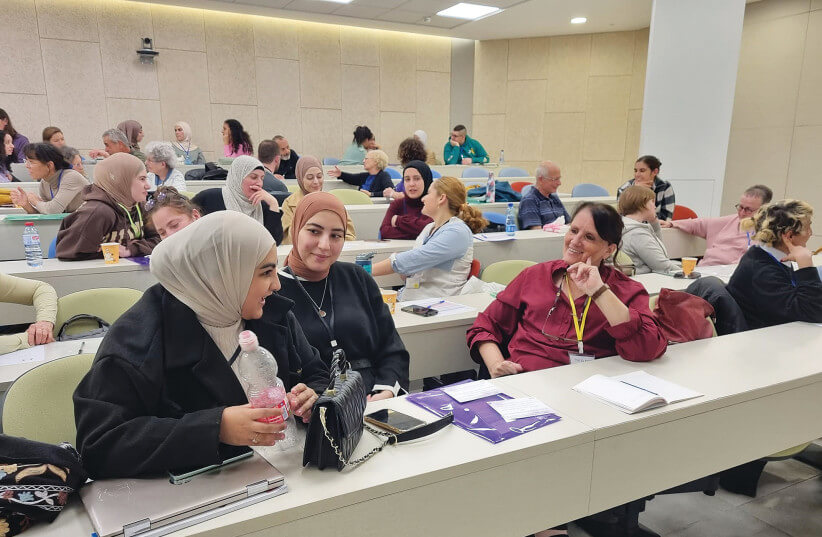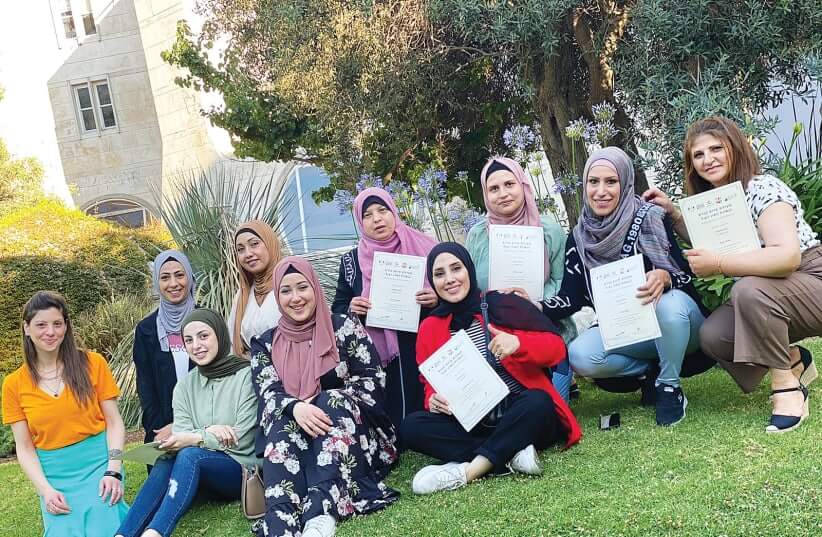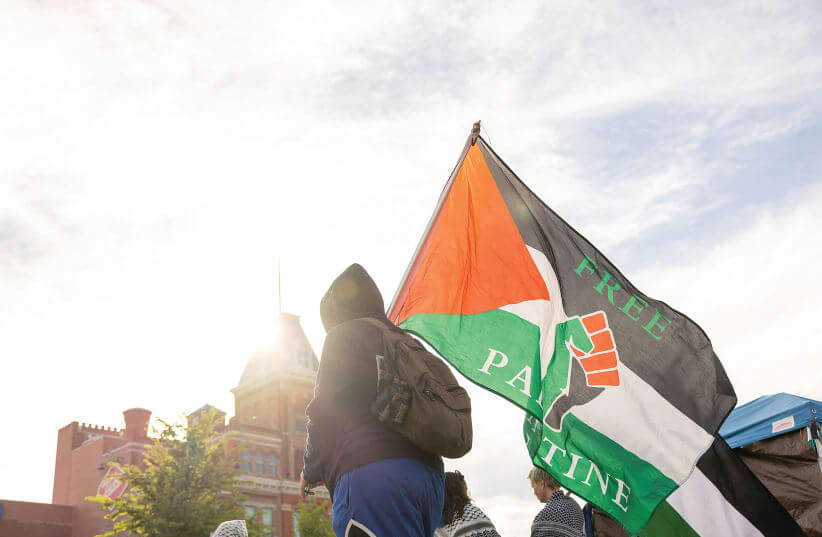The original article is published at JPost.com
Lissan teaches Hebrew language to Arab women in an effort to promote “linguistic justice and equal access to basic rights and services for all Jerusalem residents.”
When Jerusalem residents Talia Vekshtein and Sirin Smoom ascended the bimah to address the congregation at Manhattan’s B’nai Jeshurun on a Shabbat morning in May, they were not sure what to expect.
The two Israeli friends and colleagues are not typical Israelis who speak at American synagogues, and the topic of their talk was not the typical content coming out of Israel – especially as the war and hostage crisis still rage in Gaza.
Fortunately, the congregation was very excited to hear stories about their organization, Lissan (the Arabic word for “tongue” or language), which, according to its website, teaches Hebrew language to Arab women in an effort to promote “linguistic justice and equal access to basic rights and services for all Jerusalem residents.”
For Smoom, a Palestinian resident of East Jerusalem, this was her first time in a Jewish house of worship.
“Visiting the synagogue for the first time left a profound impression on me,” writes Smoom in an email. “I was struck by the warmth of the community and the respectful manner in which everyone engaged in the service.

LISSAN GREW out of the desire of women in east Jerusalem to improve their Hebrew language skills. (credit: Courtesy Lissan)
“The presence of both a male and a female rabbi was noteworthy and spoke to the synagogue’s inclusivity. The rabbi’s teachings provided deep insights into Jewish beliefs and practices, and what stood out was the prayers for peace for both Israelis and Palestinians – a rare sight that fostered a deeply peaceful and inclusive atmosphere in a very holy place. The readings from the Torah further enhanced my sense of reverence to Jewish traditions.
“Overall, it was an unforgettable introduction to a place of worship that cherishes tradition, community, and spiritual contemplation.”
Vekshtein, in an email, enthuses about the congregation and the opportunity to speak about Lissan together with her colleague.
“For me, visiting B’nai Jeshurun was deeply meaningful because the space of the Shabbat morning service provided emotional processing and spiritual connection within a supportive and inclusive community framework.
“These days, when our land is fraught and it’s so difficult to express all the pain and sorrow, I didn’t expect such an emotional experience far from home, outside my local community.
“It was moving for me to witness a Jewish community that, in the name of Judaism, sanctifies values that are both Jewish and universal – human dignity, equality and justice, and calls for peace and healing between the Israeli and Palestinian peoples.
“Experiencing this together with Sirin, and seeing her warmly welcomed with open arms and love, was also deeply meaningful and touching for me. The warm reception we received at B’nai Jeshurun showed me that we have true shared values within the American Jewish community and that together, even in this time, there are large and strong communities that believe Jerusalem and the region as a whole can look different.”
For B’nai Jeshurun’s longtime rabbi, J. Rolando Matalon, inviting the two made perfect sense and fit in with the mission of the shul.
“We brought the women from Lissan at the suggestion of one of our members who is a supporter of the organization,” he explains by email.
“At this time of increased tension and animosity between the Jewish and Palestinian communities, it is important to highlight some of the many examples of partnership and cooperation, and positive contributions to peaceful coexistence.
“Shortly after the presentation by the women from Lissan, we all saw the hatred that was unleashed on Jerusalem Day, which was a desecration of Torah, of Judaism, and of Israel’s Declaration of Independence. We cannot allow that to prevail; we must help the way of Lissan to prevail.”
While Smoom and Vekshtein smiled throughout their talk, shared their experiences warmly and openly and seemed comfortable together, their mission after October 7 is complex and at times difficult. Lissan’s continued success is due to the hard work Smoom, Vekshtein, and their teams have devoted to the program, especially in the difficult period since October 7.
Origins of the organization
LISSAN GREW out of the desire of women in east Jerusalem to improve their Hebrew-language skills.
“Ten years ago, some east Jerusalem neighborhood women approached two Hebrew University students to ask them to teach them Hebrew,” Vekshtein recounts. “They [the women] wanted to be able to speak with their doctors in hospitals, take the light rail, buy things on Jaffa Road, and find better employment.”
What started with once-a-week informal meetings has grown to a robust program which utilizes 50 Jewish and Arab, Israeli and Palestinian volunteers – mostly women – who co-teach Hebrew to over 500 people a year.
Smoom’s own mother is an example of someone who benefited from the program. With improved Hebrew-language skills, the Jerusalem teacher was better able to understand financial and legal documents.
Smoom notes the importance for Arab working women to feel comfortable in Hebrew. “You need to have [decent] Hebrew for any job raise or a higher position. You can’t do it only in Arabic.”
Smoom cites troubling poverty and unemployment data. She notes that more than 60% of families in east Jerusalem live under the poverty line and cites data indicating a greater than 75% unemployment rate. In addition, she points out that more than 70% have no or weak Hebrew-language skills.
Smoom points out the benefits for all east Jerusalem residents if they learn to feel comfortable in Hebrew, noting, “We get most of our services in Hebrew.”
For university students – even those studying in Palestinian universities – mastery of Hebrew is especially important. “You have to get your Hebrew to a high enough level to integrate [into the workforce], or take medical, pharmacy or law exams.”
But, as Vekshtein points out, finding culturally sensitive Hebrew teaching materials can be challenging since “most content is olim-focused and doesn’t take into account cultural needs.” As a result, Lissan writes content and curriculum with its students in mind.
Learning together provides opportunities for this nonhomogeneous group of students – and their teachers – to learn about each other’s lives and cultures.
Vekshtein recalls a recent class where a Christian Palestinian shared about her son’s wedding. “A Muslim student was so curious to hear more!”
It is also an opportunity to tackle head-on the sometimes difficult and complex realities of daily life in Israel. Vekshtein and Smoom note that, after October 7, some sensitive situations have come up.
Smoom notes, “Our students are asking to learn more key words they can use at checkpoints. It is difficult but important for self-protection.” This is an area where co-teaching is useful. She adds, “Most Israeli teachers don’t know about this. We take the experience of our Palestinian teachers who went through this experience and have a dialogue with their students.”
The period right after October 7 posed many challenges. On the most basic level, Smoom notes, the education system was closed and teachers and students were not available for in-person learning. “All of our staff are moms, and they had to stay home with their kids when schools were shut down.”
Vekshtein elaborates, “Staff had to deal with no school and husbands in the army. Other staff members were stuck behind the wall and couldn’t go to the other side.”
In addition, the course was traditionally offered on the Hebrew University campus, which was shut down right after October 7.
But logistics were not the biggest challenge. “It was hard on so many levels,” notes Smoom. “We continued talking about it [the war]” and how to proceed.
Smoom and Vekshtein decided to send surveys to their students and volunteers and were pleased to learn that “90% of the students said yes, they want to go back [to their Hebrew studies], they wanted a routine!” Learning initially resumed via Zoom.
Lissan brought in outside facilitators to talk about and process thoughts and feelings which Vekshtein acknowledges were “complex.” She was pleased that the staff ultimately said, “We put our trust in you and know you can make it happen.”
Vekshtein notes that they all learned ways of having effective dialogues without avoiding difficult topics. “This is not a dialogue group, but we learned how to deal with it if it comes up.”
Vekshtein and Smoom were pleased they were able to reopen in person. Vekshtein reports, “We ended up at full capacity, which enabled positive encounters during this time.”
Lissan’s important work of teaching Hebrew continues. Vekshtein reflects, “I never thought of our work as trauma healing but it is keeping us seeing the humanity of the other side.”
The B’nai Jeshurun congregants returned home with an unusual window into one segment of Israeli society whose members are reaping the benefits of their hard work with “the other.”









